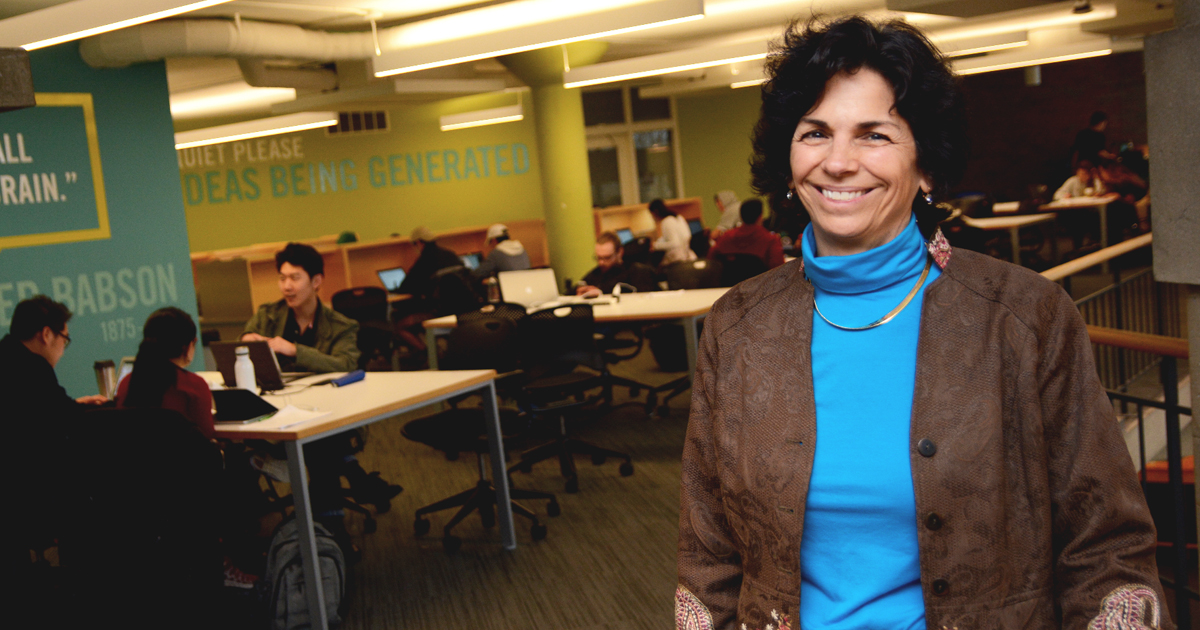Advancing Breakthrough Innovation with Gina O’Connor

Gina O’Connor joined Babson in January 2019 as a professor of innovation management following nearly 30 years at the Lally School of Management at Rensselaer Polytechnic Institute. She conducts research and develops curricula that facilitates learning for graduate students and executives based on her findings on breakthrough innovation capabilities in large mature companies.
Widely published and a frequent speaker, she has co-authored three books on breakthrough innovation. The second of those: Grabbing Lightning: Building a Capability for Breakthrough Innovation, was named one of the top three business books of the year by Strategy+Business magazine. In 2018, she was named a Crawford Fellow by the Product Development and Management Association, one of only six recipients of that award.
We recently had the chance to ask her a few questions.
What is the key to breakthrough innovation within companies?
For large companies that are not owner- or founder-led, innovation has to be a distinct and separate function. And, it must be a robust operation with a clear vision and mandate, established metrics, and dedicated staff. It should not be seen simply as a process, or a cultural characteristic, or driven by champions alone. Otherwise, innovation of a truly game-changing nature will be undermined. The innovation function must be charged with translating emerging science, technology, and business models into new platforms of growth that will fuel the company’s future. While everyone in the company is expected to use innovative thinking to improve the customer experience, a distinct group needs to be given the mandate to chart the course of the company’s future through breakthrough innovation.
Successful organizations need to be ambidextrous. Do you focus on your core or do you explore? What should the balance be? In general, companies do not know how to explore very well. Our research is designed to help organizations get better at exploring by developing a capability for strategic/breakthrough innovation.
“The innovation function must be charged with translating emerging science, technology, and business models into new platforms of growth that will fuel the company’s future.”
Gina O'Connor, Professor
What attracted you to Babson?
I can’t tell you how wonderful it is to have the opportunity to join Babson to advance further what has already been 25 years of work. Many of the thought leaders in the field of innovation are right here at Babson, and they are colleagues that have participated with me on the Radical Innovation Research program.
With the strong relationships Babson faculty and alumni have with businesses, I believe that we will really be able to move the needle in helping large established companies build this capability.
Still in the very early stages, we are planning to expand work that we are doing with professional associations of R&D and innovation managers. I am excited about the partnerships Babson will be developing with them.
What are the barriers to breakthrough innovation?
While there are many, one of the biggest barriers to achieving sustained success with breakthrough innovation is talent management.
People involved in research and development understand that some ideas will not pan out; that failure is part of experimenting. However, what we find is that the new business creation professionals who incubate these projects are held to different standards. These folks get punished if ideas do not yield results!
We also find that new business creation personnel are not selected into their roles purposefully. In fact, most volunteer into those roles. And, we find that oftentimes, there’s a mismatch between their skills and characteristics, and the job’s requirements. Individuals who have demonstrated excellence in operational roles tend to become anxious in an innovative environment, where uncertainty and ambiguity reign. They feel like they are navigating in a fog. In contrast, people who are more naturally inclined to work in the world of uncertainty find themselves demotivated and depressed in operationally oriented roles.
The challenge we are now working on is to develop talent management selection and assessment tools for companies, along with tools for career development within an innovation function.
Another big barrier in the United States is to get past corporate America’s short-term focus. Unfortunately, in the United States, many companies are still very focused on quarterly earnings reporting.
How can we help analysts put a true value on innovation’s long-term impact and on investments a company makes in research and development? There is a negative correlation between investment in research and development and a company’s value in the capital markets. However, if you add incubation into the equation over the long term, then their market value is positively correlated with investments in research and development.
What are you passionate about outside of your research?
My father, who was 70 and three times retired, was looking for his next gig. At around that time, he received a $100,000 inheritance, which he used to establish our family foundation. My parents challenged their five kids (myself included) to figure out a mission that we could all get behind to make a difference. We experimented with a few different ideas before we landed on establishing the Fostering Hope Foundation in Colorado Springs, Colorado.
Created more than 12 years ago and working with faith-based organizations, the Fostering Hope Foundation affirms and supports foster parents in their task of caring for neglected and abused children. The work of foster parents is extremely demanding, complex, and can be overwhelming. Our volunteers and community partners serve as an extended family for the foster parents and to the children entrusted to them.
We support the kids into adulthood, providing services that range from transportation to and from medical appointments, helping with homework, and being advocates for them in their schools, to finding them internships with local businesses. Once they turn 18, we have an adult transition program. To date, more than 600 kids have participated.
Each foster family is paired with a team of volunteers: we currently have 40 active volunteer teams. Our next goal is to replicate this program across other cities in the U.S.





